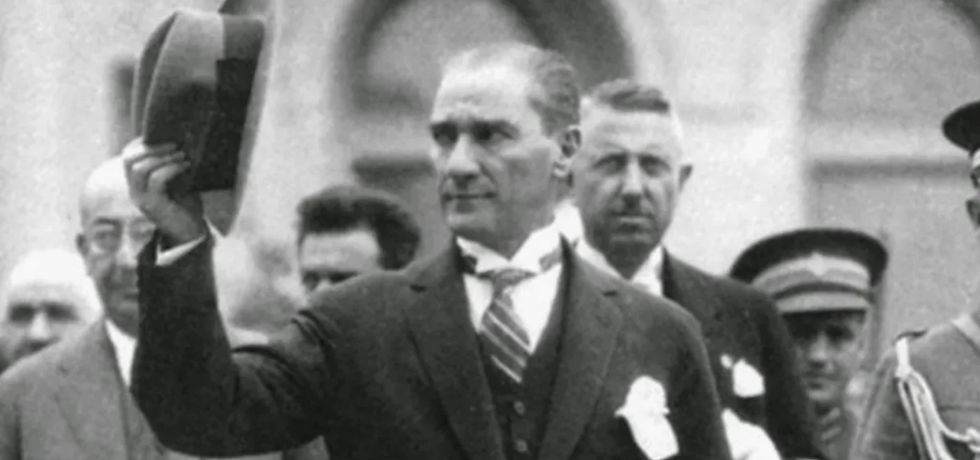F - 74 : Ataturk and his Tea
- hbanziger
- Jun 7, 2022
- 3 min read
Had it not been for our friend Ibrahim, a merchant in the Grand Bazaar, we would never have learnt about the origin of Turkish Tea. As customary, he invites his visitors for tea and coffee. The invitation comes with no obligation. It is part of Turkish hospitality. Until Ibrahim said so, it did not occur to us that the tea we were having was grown in Turkey and that Turks were the world's biggest tea drinkers.

Turkish People love Photos of Tea Glasses with Istanbul's Maiden Tower, an old Light House, in the Background. There are dozens on the Internet.
By the end of the First World War, Turkey was reduced to Anatolia and lost Mesopotamia (Iraq), the Levant (Syria, Lebanon and Palestine) and the coastal strip on the eastern Red Sea down to Yemen. For a country with a deep coffee culture, the loss of Northern Yemen where coffee was grown was immediately felt. Until then, coffee was a domestic product that was shipped without any customs to every part of the Ottoman Empire. Suddenly, it was outside the borders and had to be imported for hard foreign currency, something war-torn Turkey did not have. Coffee consumption declined sharply. When still available, it was stretched with cardamon and other substitutes. Pure coffee became a luxury for most Turks.

North Yemen with its Coffee Plantations was part of
the Ottoman Empire until 1918
Tea was known in Turkey for a long time. It had reached the country for centuries via the silk road. But coffee from Yemen was cheaper and the coffee culture firmly establish. Expensive tea from China had no chance. Even when Russia planted tea in its newly acquired territory of Georgia by the 19th century, Turkey hardly noticed. Georgian Tea was shipped to Russia where it had enthusiastic followers. The only Turks who noticed were a few botanists who wondered if tea could also be grown in Turkey’s East. But without customers, their ideas got nowhere. The Ottoman Empire stayed in the grip of coffee. Had the English Embassy not served tea during its afternoon receptions, Turkish society may not have seen tea culture at all.

Amongst many other Reforms, Kemal Ataturk introduced Turkey to Tea in 1924
The acute coffee shortage after the First World War changed all that. The coffee houses had no business anymore. A substitute was urgently needed. By 1924, Kemal Ataturk, the Turkish President, established the Central Tea Nursery with the mission to plant tea in the eastern province of Rize where climate conditions and soil were best. Success did not come over night. With no prior knowledge of tea plantation and fermentation, it took Turkey a good dozen years to figure out all aspects. But at the outbreak of the Second World War, tea production was in full swing. The collapse of global commerce during the Great Depression extended throughout 1945. For Turkey it did not matter. It had its own drink. Tea became the nation’s favourite and has ever since stayed on top.

The Mountains in Rize Province provide the Humidity needed for Tea Plantations
Turkey today is the country with the highest tea consumption in the world. With 3.16 kg per head it beats Ireland and the UK handsomely (2.19 kg, resp. 1.94 kg). China with 0.57 kg per head is in the distant 20th position. With 175’000 tons of tea produced per annum, Turkey is also the fifth largest tea producer in the world, only preceded by China (2’400’000 t), India (900’000 t), Kenya (350’000 t) and Sri Lanka (300’000 t). The numbers are from 2020.

Plucking young Tea Leaves is still a very manual Business
Whilst Turkish Tea production started with Black Tea (fully oxidized leaves), today’s producers also offer a wide range of white and green teas. In the local bazaars there are all sorts of blends. Green teas with mint leaves are often offered or white teas mixed with dried lotus flowers. There seems to be no end to creativity in Turkey when it comes to blends. Tea is always consumed very hot with a bit of sugar but rarely with milk or lemon. For Turks, these two ingredients dilute the original taste and are to be avoided.

Turkish Tea is served hot but not over boiled - usually with a Lump of Sugar
Tea production started as a state monopoly in 1924. It probably would not have taken off without the helping hand of President Ataturk. By the 1980 though, the monopoly had slipped into political playground where patronage and nepotism were ripe. The monopoly was subsequently lifted. Private sector companies were now allowed to grow tea following the state's quality standards. They developed the tea offering further and also established Turkey’s position in the world’s export markets. Today, Germany is one of the biggest importers of Turkish tea.

Turkish Tea blends perfectly well with the Turkish Cuisine
The time to taste the blends will be August 2022!
Comments